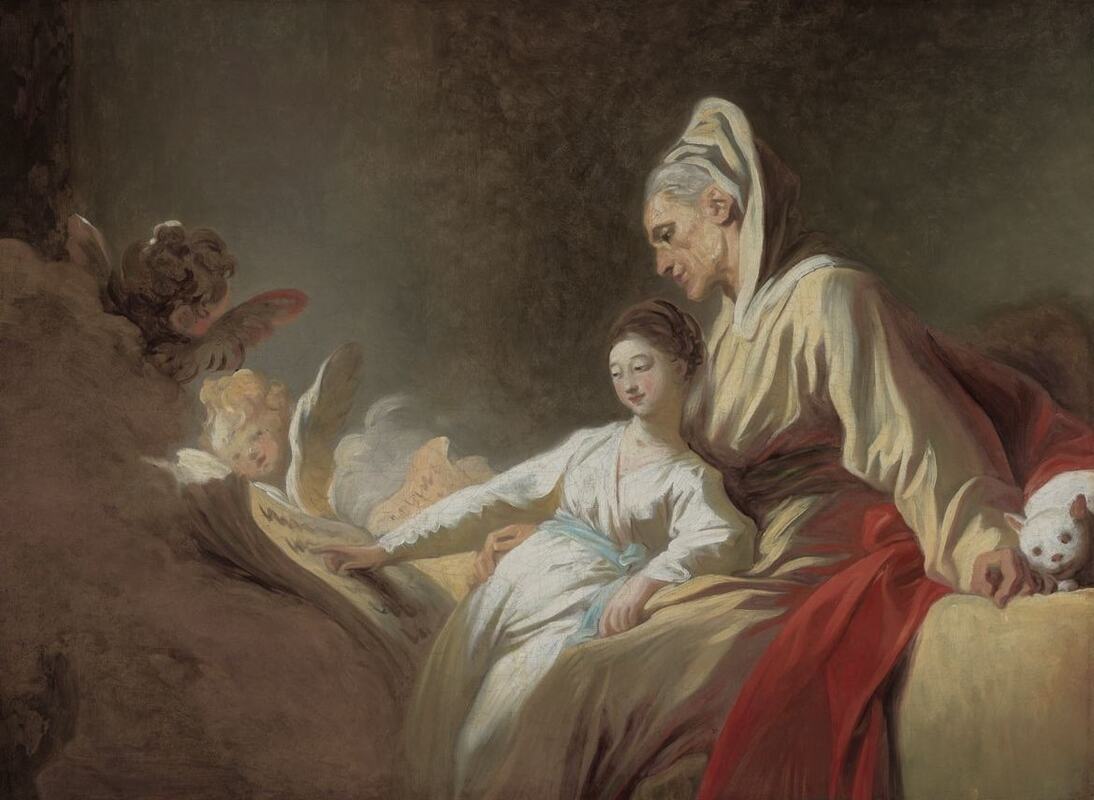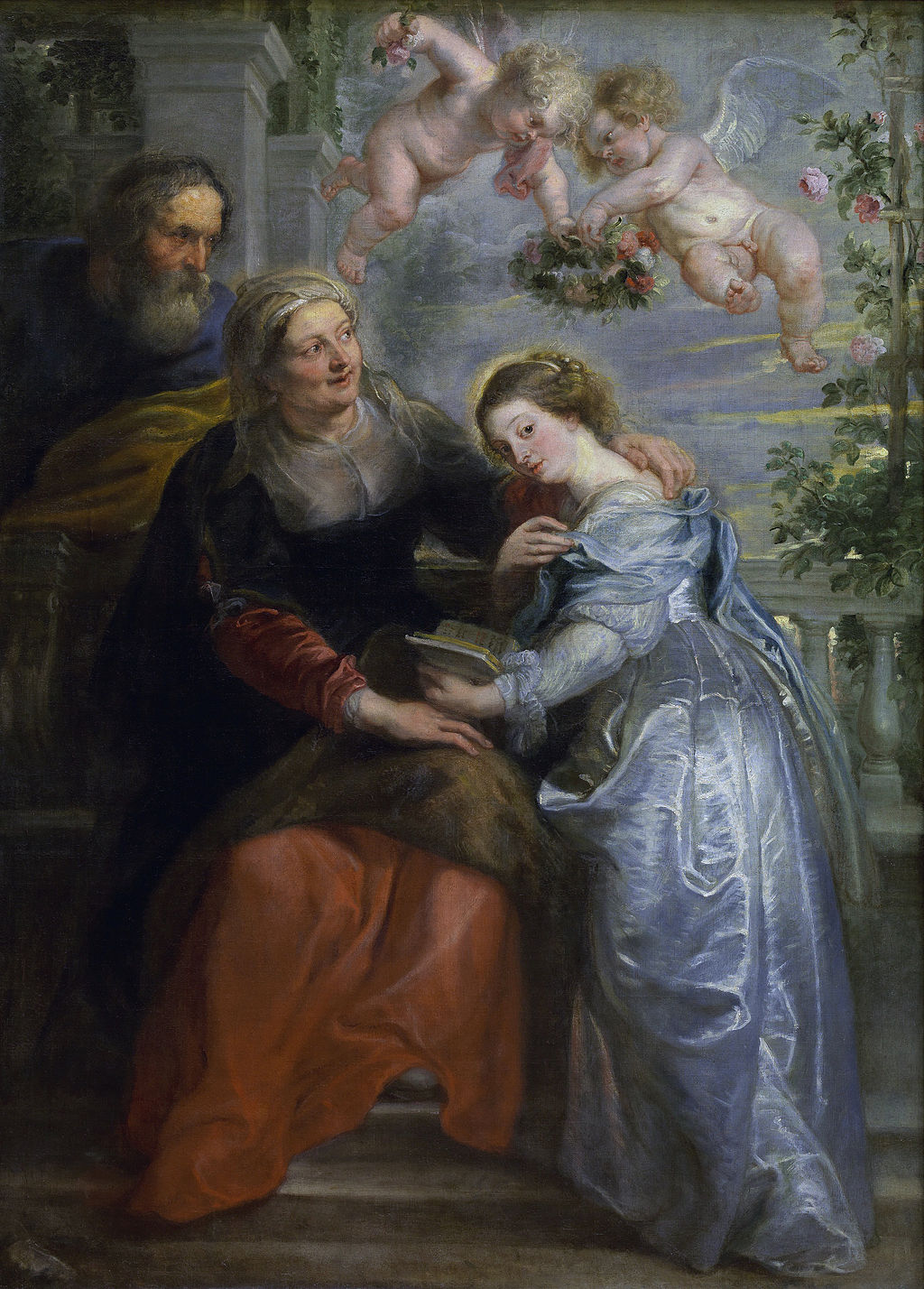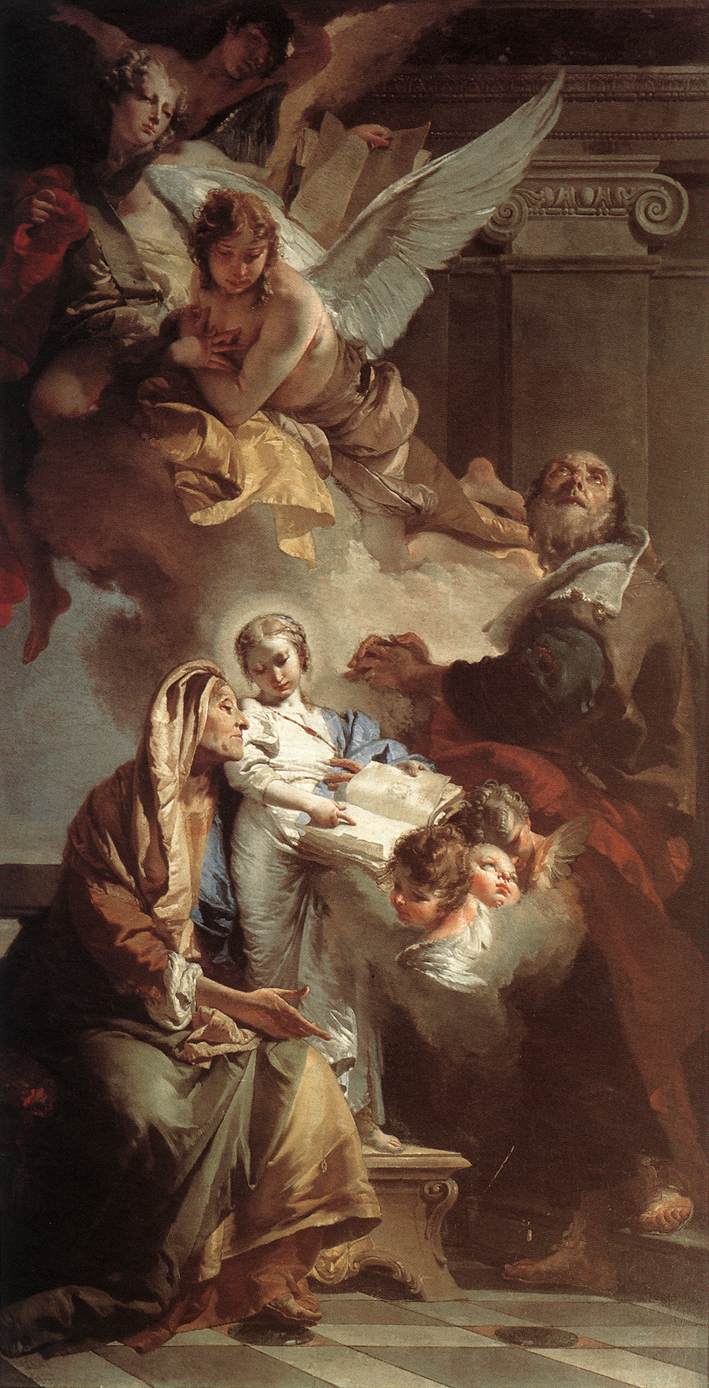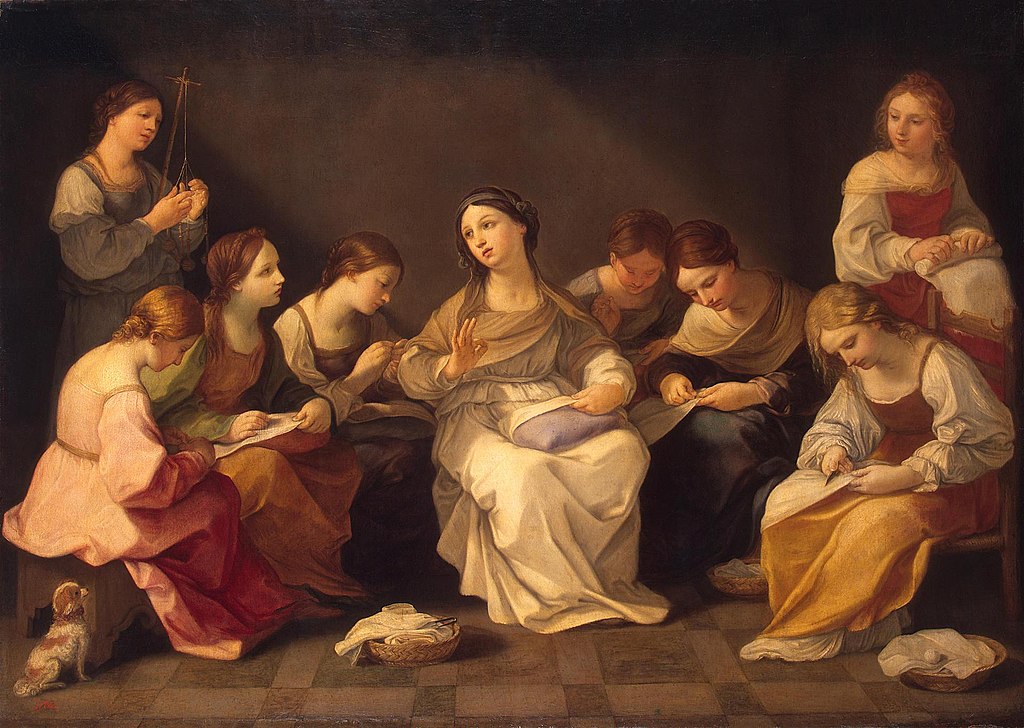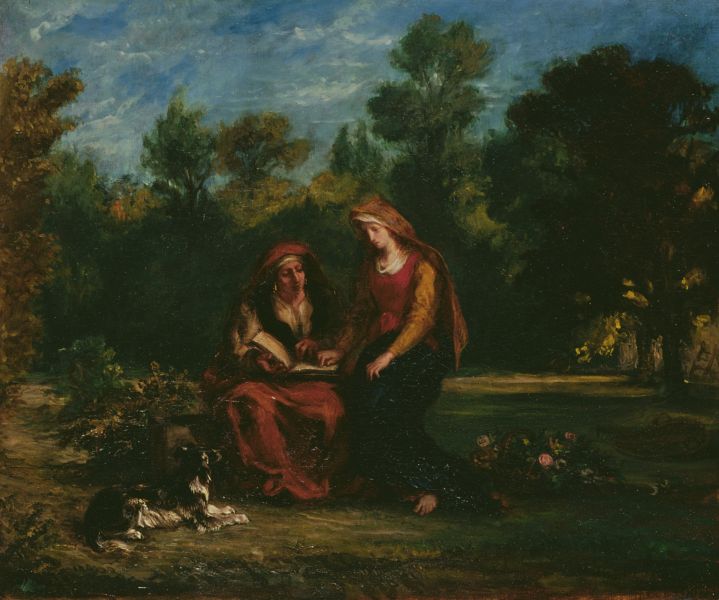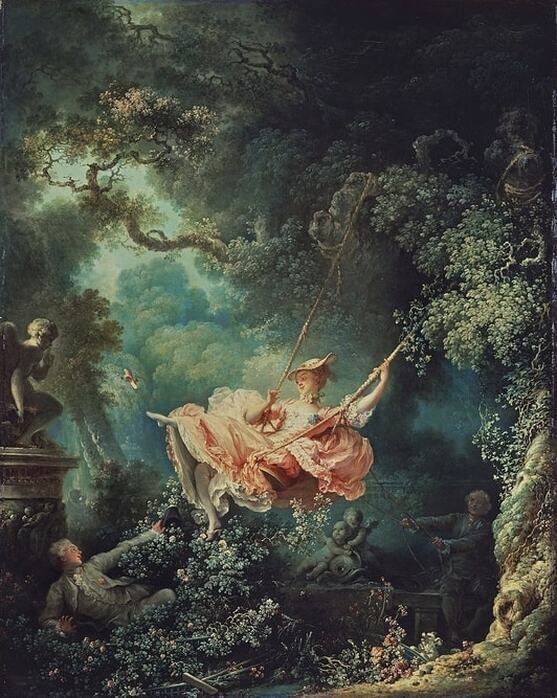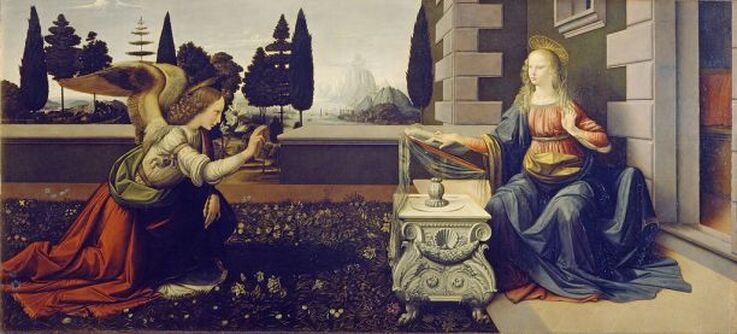|
Where? Gallery 7 of the Legion of Honor Museum
When? About 1773 What do you see? A young Mary comfortably leans back against her mother, Saint Anne, who teaches the Virgin Mary about the Bible. Mary has her finger on the Bible questioning her mother about a certain aspect. However, Mary seems confident as well and enjoys this activity with her mother. Fragonard included strong contrasts between mother and daughter. Mary is tiny and has a pale, doll-like face. Her oversized mother looks like a wise and experienced woman. On the left, they are accompanied by two small angels hovering next to the Bible to give them divine inspiration. On the right, they are joined by a white cat. Fragonard paints a mysterious light source in the background giving this painting a magical feel. The bottom left of the painting probably has been damaged over time, but, interestingly, the vaguely applied pink and brown paints add to the magical feeling of this work. Background: Fragonard got the inspiration for this painting from earlier works on this theme by Peter Paul Rubens and Giovanni Battista Tiepolo. Rubens painted the theme between 1630 and 1635 and this work is on display in The Royal Museums of Fine Arts in Antwerp. Between 1730 and 1732, Tiepolo painted the theme multiple times, including a version in the Santa Maria della Fava Church in Venice. Fragonard first copied the works of these artists but then created his own, unique composition of this theme. However, when he finished the work, it was not received well by the art critics of that time. It inspired him to create some other versions of this work.
The youth of Mary: The youth of the Virgin Mary is described in the apocryphal Gospel of James. Mary is the daughter of Saints Anne and Joachim. They were wealthy people, but Anne was infertile. After a desperate prayer to God, an angel appeared to her promising a child that would become famous. Anne became pregnant without intercourse with her husband.
When Mary was three years old, her parents brought her to the Temple where she would be raised by the priests and received food from the hand of an angel. When she was 12 years old, God picked Joseph, a widower with older children, to be Mary’s guardian and to become her husband when she was old enough. And when Mary was 16 years old, she became pregnant without having intercourse. Joseph actually only discovered her pregnancy when he came back from a house-building trip when she was already six months pregnant. The Education of the Virgin: The story of Saint Anne teaching her daughter Mary about the Bible only developed in the 11th century AD. It is not mentioned in the Gospel of James, which is the main source of information about Mary’s youth. In contrast, the Gospel of James mentions that Mary lived with the priests at the Temple between her third and twelfth year. The only skill of Mary mentioned in the gospel is that she was good at weaving. But 11th-century logic told priests and scholars that, as the Mother of Jesus, Mary also had to be able to read and be knowledgeable about the Bible. And so, artists in the next centuries started to depict Saint Anne teaching Mary about the Bible. Multiple versions: Fragonard created multiple versions of The Education of the Virgin. The version in the Legion of Honor Museum was probably the first version and painted around 1773. After that, he made two drawings of the painting for which he used the same composition but experimented with different lighting effects. During the second half of the 1770s, Fragonard created a second series on this topic. In these later paintings, Mary is no longer looking at the Bible but at her mother instead. The education of the virgin was a theme that multiple artists have used over time. Besides Rubens and Tiepolo, Guido Reni painted between 1640 and 1642 a version in the Hermitage Museum. And between 1842 and 1852, Eugene Delacroix also painted a couple of versions of this theme, one in The National Museum of Western Art in Tokyo, and another one is owned by the Louvre.
Who is Fragonard? Jean-Honoré Fragonard was born in 1732 in Grasse in the Southeast of France and died in 1806 in Paris. He started his career as a fairly traditional artist, but during a trip to Italy in his late twenties, he started to become interested in more theatrical works. He got inspired by the works of artists like Hals, Rembrandt, Rubens, and Tiepolo, and decided to create colorful, chaotic paintings about love and happiness.Among these paintings is his best-known work, The Swing in the Wallace Collection in London.
However, his new style of painting was not well-received by everybody, and he still continued to paint some more traditional religious works on commission. After the French Revolution in 1789, Fragonard continued to paint, but his name was forgotten quickly.
Fun fact: The theme of the education of the virgin has contributed significantly to the development of female literacy. Whereas in the early Middle Ages only men were depicted holding a book, the increasing popularity of Saint Anne teaching Mary how to read the Bible was a sign to people that it was also important for women to learn how to read.
Images of Mary being able to read the Bible did not remain restricted to Saint Anne teaching her. The Annunciation by Leonardo da Vinci in the Uffizi Museum shows that Mary is reading the Bible when the Archangel Gabriel announces to her that she will be the Mother of Jesus.
Written by Eelco Kappe
References:
0 Comments
Leave a Reply. |
Categories
All
|
- Home
- Blog
-
Museums
- Alte Pinakothek
- Art Institute of Chicago
- Baltimore Museum of Art
- Barber Institute of Fine Arts
- Bargello
- Barnes Foundation
- British Museum
- Church of Sant’Anastasia
- Cleveland Museum of Art
- Courtauld Institute of Art
- Detroit Institute of Arts
- Frans Hals Museum
- Galleria Borghese
- Gallerie dell'Accademia
- Getty Museum
- Guggenheim
- Hermitage Museum
- Kunsthistorisches Museum
- Kunstmuseum Basel
- Legion of Honor Museum
- Louvre
- Mauritshuis
- Metropolitan Museum of Art
- Musee d’Orsay
- Museum of Fine Arts in Boston
- Museum of Modern Art
- National Gallery in London
- National Gallery of Art
- National Museum in Poznań
- Norton Simon Museum
- Ny Carlsberg Glyptotek
- Palace of Versailles
- Palazzo Pitti
- Palazzo Vecchio
- Petit Palais
- Philadelphia Museum of Art
- Prado
- Pushkin Museum
- Ravenna Art Museum
- Rijksmuseum
- San Diego Museum of Art
- Santa Maria delle Grazie
- St. Peter's Basilica
- Städel Museum
- Statens Museum for Kunst
- Tate Britain
- Tate Modern
- Timken Museum of Art
- Uffizi
- Vatican Museums
- Wallace Collection
-
Artists
- Altdorfer
- Anguissola
- Berlin Painter
- Bosch
- Botticelli
- Boucher
- Bronzino
- Bruegel the Elder
- Brunelleschi
- Cabanel
- Caillebotte
- Canova
- Caravaggio
- Carpeaux
- Cezanne
- Cimabue
- David
- Degas
- Delacroix
- De Maria
- Donatello
- El Greco
- Fontana
- Fra Angelico
- Fragonard
- Gauguin
- Gentileschi
- Gericault
- Gonzalez-Torres
- Goya
- Hals
- Hogarth
- Hokusai
- Ingres
- Leonardo da Vinci
- Lippi, Filippo
- Longhi, Barbara
- Lorrain
- Makovsky
- Manet
- Massys
- Matisse
- Merian
- Michelangelo
- Mochi
- Modigliani
- Monet
- Panini
- Parmigianino
- Perugino
- Picasso
- Pisanello
- Raphael
- Rembrandt
- Renoir
- Reynolds
- Rivera
- Rodin
- Rubens
- Scultori
- Seurat
- Steen
- Tintoretto
- Titian
- Toulouse-Lautrec
- Turner
- Uccello
- Van der Weyden
- Van Dyck
- Van Eyck
- Van Gogh
- Van Hemessen
- Vasari
- Velazquez
- Vermeer
- Veronese
- Vigée Le Brun
-
Locations
- Books
- About Us

